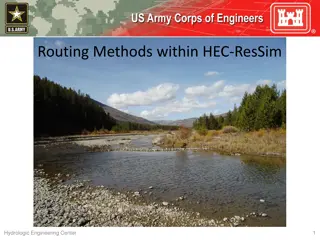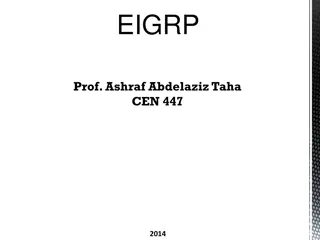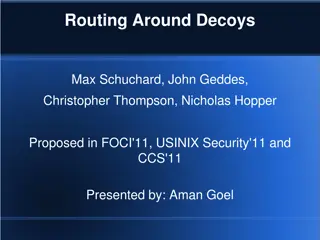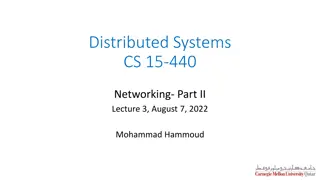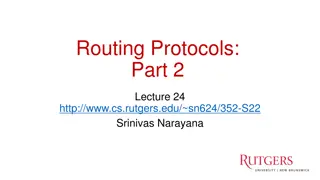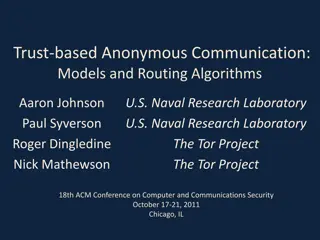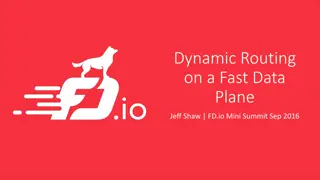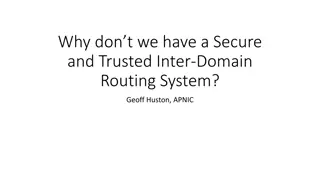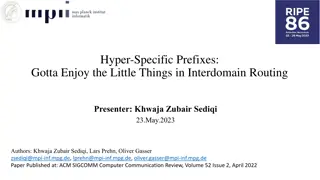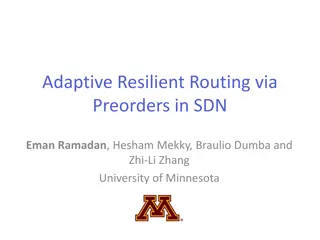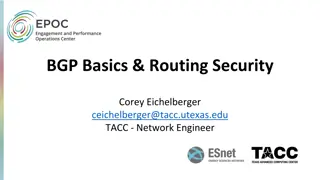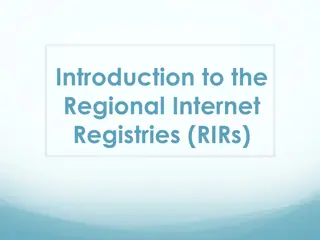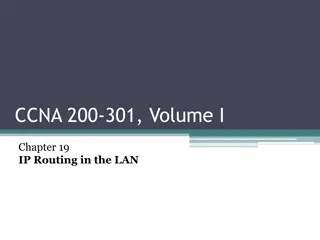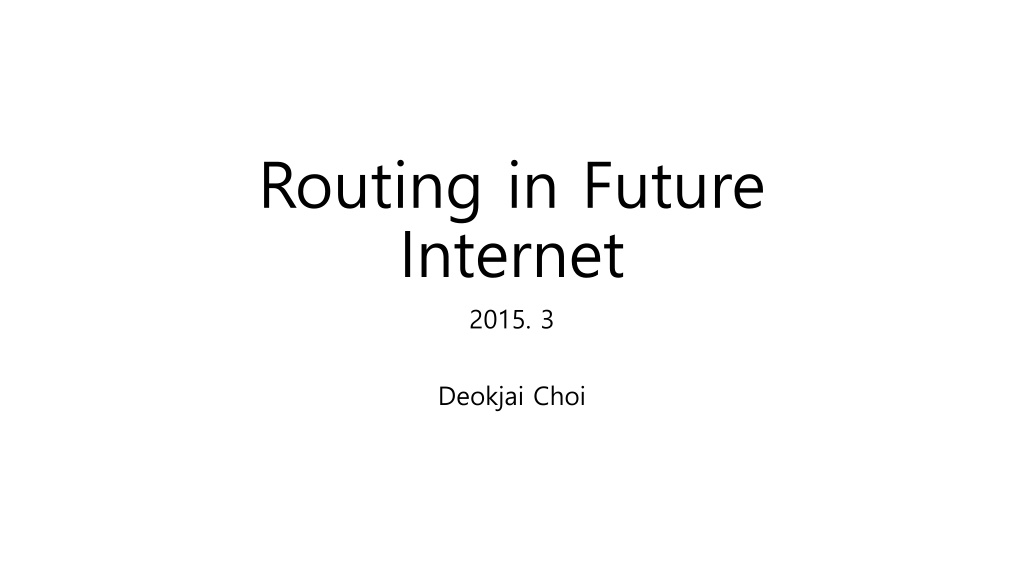
Understanding the Evolution of Internet Routing
Explore the historical progression, challenges, and current issues in Internet routing, shedding light on BGP growth, architectural design decisions, challenges like mobility and multi-path routing, and problems faced in current wireless environments.
Download Presentation

Please find below an Image/Link to download the presentation.
The content on the website is provided AS IS for your information and personal use only. It may not be sold, licensed, or shared on other websites without obtaining consent from the author. If you encounter any issues during the download, it is possible that the publisher has removed the file from their server.
You are allowed to download the files provided on this website for personal or commercial use, subject to the condition that they are used lawfully. All files are the property of their respective owners.
The content on the website is provided AS IS for your information and personal use only. It may not be sold, licensed, or shared on other websites without obtaining consent from the author.
E N D
Presentation Transcript
Routing in Future Internet 2015. 3 Deokjai Choi
Brief History of IP Original design goals 1ststage Network interoperability End to end connectivity Idea Keeping the network core simple and independent from upper and lower layer protocols Routing Protocols in early stage of IP network To compute the shortest path between source and destination Internet was composed of a few nodes from non-profit institutions
Brief History of IP Introduction of AS 2ndstage Result of growth Computing shortest path between any 2 nodes was not easy Hierarchical structure IGP, EGP (-> BGP) Big success: 207 millions networks/24bits New Problems coming
Challenges in Future Internet Routing Most challenges faced by the Internet today are consequence s of the architectural design decisions and unexpected fast gr owth. Original internet design did not anticipated following trend: Mobility Multihoming Multipath Path Customization
Problems of Current Internet: Mobility TCP operation in wireless environment Created to work for wired environment Wireless and mobile environment increasing more in future Experiencing packet loss will trigger congestion control which will reduce packet transmission rate. In wireless environment, it doesn t work.
Problems of Current Internet: Mobility Addressing and routing in Mobile environment Hierarchical structure allows network prefix aggregation. It improves routing scalability. The hierarchical structure of the Internet has led to a geographical organization of IP addresses. IP addresses play roles of identifier as well as locator which reflects geographical location overloaded semantics Fundamental obstacle to mobility A station must always reconfigure its address to one topologically coherent with the visited network. It takes time, and is possible to lose packet during this period.
Current Internet state for mobility MIPv6 does not require FA. The tunnel is established btw HA and mobile node. Using routing header extension, corresponding node can send packet directly mobile node without going through HA. This improvement is only possible in fully routable IPv6 networks. IPv6 has not been fully applied in practice. Reason for this problem: overloaded semantics (locator + identifier)
Problems of Current Internet: Multihoming 2 cases: multihomed stations and networks Multiple IP addresses or more than one access network from disjoint address prefixes, probably from different ISPs. Good to avoid address reconfiguration Not assigned by ISPs (not provided assigned), but assigned by a Regional Internet Register (RIR) Multihomed network is independent of the ISP.
Advantages of multihomed network Increased communication reliability Used for Traffic engineering, throughput maximization, and cost reduction More expensive ISPs are used for sensitive traffic whereas cheaper ones are used otherwise) No need to reconfigure network address after an ISP change.
Problems of multihomed nework Scalability Non-aggregated prefixes must be announced to all ASes in the Internet, violating hierarchical address organization. In the last few years, the number of BGP entries has exponentially increased and is still moving up. From 2012 January to 2013 January, approximately 50,000 new active BGP entries have shown up. We need to have better solution for multihomed network.
Problems of current Internet: Multipath Originally, the Internet was designed based on single-path routing. Advantages of multipath routing Increased available bandwidth, so provides shorter delays Increased fault tolerance Traffic engineering and load balancing possible. Obstacles for deployment Scalability from storing multipaths to every other destination Commercial agreement among ISPs Traffic control such as congestion control becomes more difficult.
Programmable path If users are able to configure paths, then Internet paths will be decoupled from routing protocols and agreements of ISPs. The best path could be chosen according to user-level requirements. The Internet must handle user-level metrics and the current ISPs would have to be adapted to provide this new customized service. The freedom for users to choose paths can stimulate competition, and it leads to a reduction on the access costs. Disadvantages Increased complexity: users or agents would need wide network knowledge. It may require nodes maintaining multiple customized paths, impacting scalablity.
Programmable path SDN could be an example for this trend. It neither radically changes the forwarding elements nor the contents of a packet. Controller manages the forwarding table of a switch via a programmable interface. Control decisions are taken by an external controller regarding path programmability.
Router Scalability One of the most critical challenges in Future Internet design. The unlimited increase on the number of entries in FIBs and RIBs may impact the performance of packet forwarding. Since the beginning of the 1990 s the number of active BGP entries in FIBs has increased from a few hundreds to approximately 450,000 entries. Partial address aggregation s side effects are obstacles to the Internet growth because of the address lookup and message processing time. Proposing new algorithms to improve router scalability is a major challenge to the new Internet architecture.
Scalability Threats Hierarchical organization and the consequent address aggregation aim at routing scalability. Threats Multihoming Multipath Mobility Path programming Transition to IPv6 (almost unlimited networks are possible.)
The proposed solution Many researches has conducted to solve future internet challenges . The classification of the researches as following: Loc/ID split Flat Routing Network Mobility Multiple Paths forwarding Content-based routing Programmable paths Scalability The first 4 does not affect much existing structure, but following 2 may change the structure. The last scalability issue is understandable.
Locator-identifier split (Loc/ID split) One of the proposals to incorporate mobility and multihomin g to the Internet is to decouple station topological locator fro m its identifier. The solution trying to solve overloaded semantics of the IP a ddress that limits the mobility and multihoming. Overloaded semantics of the IP address is caused by the role of IP address such as: who : endpoint identifier, as used by transport layer where : locators for the routing system how : the way to sent IP packets to their destination
Locator-identifier split (Loc/ID split) Loc/ID split solution can be divided into three subclass: Indirect forwarding Uses an intermediate system to maintain end-host s identification and corresp onding location. Network based approaches This approaches uses a network locator for forwarding procedures in internet default free zone (DFZ) and an end-host identifier within a local scope at the n etwork borders. Host based approaches This approaches uses global end-host identifiers to establish end-to-end com munications.
Loc/ID Split Indirect Forwarding The first approach is Internet Indirection Infrastructure (i3). Internet Indirection Infrastructure (i3) offers rendezvous-based communication abstraction.
Loc/ID Split Indirect Forwarding Figure (a) illustrate the proc ess of ID and IP Address inf ormation to the i3 server str ucture. Figure (b) illustrate the Pack et Forwarding process when the Source A send the Pack et to Destination with ID is B.
Loc/ID Split Network Based Approach Locator/Id Split Protocol (LISP) is one of the proposal in this a pproach. LISP focuses on Multihoming. Internet Multihoming is one site or host can have more than one IP address; from more than one Internet Service Provider s (ISP). Internet Multihoming goals is to eliminate network connectivi ty as a potential single point of failure (SPOF), in other word, its increases communication reliability.
Loc/ID Split Network Based Approach The negative impact of Multihoming is internet scalability. This pro blem regarding to BGP table growth when multihoming add more entry to the global routing table. Another problem is that using a single address field for both ident ifying a device and for determining where it is topologically locate d in the network requires optimization along two conflicting axes: for routing to be efficient, the address must be assigned topologic ally; for collections of devices to be easily and effectively managed , without the need for renumbering in response to topological cha nge (such as that caused by adding or removing attachment point s to the network or by mobility events), the address must explicitly not be tied to the topology.
Loc/ID Split Network Based Approach The approach that LISP takes to solving the routing scalability pro blem is to replace IP addresses with two new types of numbers: Routing LOCators (RLOCs), which are topologically assigned to network att achment points (and are therefore amenable to aggregation) and used for routing and forwarding of packets through the network Routing efficiency. Endpoint Identifiers (EIDs), which are assigned independently from the net work topology, are used for numbering devices, and are aggregated along administrative boundaries. Mobility and multihoming Both RLOCs and EIDs are syntactically identical to IP addresses.
Loc/ID Split Network Based Approach Figure (a) illustrates the direc t forwarding process in LISP. Figure (b) when there is no mapping information in sour ce RLOC, LISP perform Map- Reply process to get new Ma p information and store it. Protocol required for getting mapping information
Loc/ID Split Host-based Approach One of the approach in Loc/ID split is Host Identity Protocol ( HIP) The HIP supports an architecture that decouples the transpor t layer from the IP layer by using public/private key pairs, inst ead of IP addresses, as host identities. When a host used HIP, the overlying protocol sublayer (Socke t connection or SA (security association)) are bound to repres entations of these host identities, and IP addresses are only u sed for packet forwarding.
Loc/ID Split Host-based Approach To overcome the deficiencies of current Internet, HIP formally prop oses a new architecture for Loc/ID split using the concepts of: Identity, an abstraction to identify the node. Identifier, a binary sequence used in the identification process. Identifier in HIP consist of: Host Identifier: a public cryptographic key used as a name for Host Identit y. Host Identity Tag (HIT): A 128-bit datum created by taking a hash over a H ost Identifier (public cryptographic key) In host identification, HIT is used as a host name that globally kno wn.
Loc/ID Split Host Based Approach Cryptographic key is given to each node for security reason. This key is used as an identity. Using hashing, this various size key is converted to the HIT (Host Identity Tag) which is uniform size as well as globally unique. Each node needs to register its HIT-IP address pair to the server. It helps mobile node and multi homing. When application or TCP process tries to bind, it uses HIT. But to communicate each other, HIT should be resolved into IP address Using server. (is called HIP)
Loc/ID Split Host-based Approach HIP introduce Rendezvous Serv er (R) as a place to match HIT with the IP Address. Figure (a) illustrates Rendezvou s Server Forwarding in HIP for first packet sent. Figure (b) illustrates packet for warding process after the conn ection is formed between sour ce and destination.
Loc/ID Split Host-based Approach To know the HIT of the nodes in HIP, there are three alternati ve configuration: First, configure the HITs of the peer hosts directly into the applicatio n. Second, change the mapping from DNS names to IP addresses in a way that resolving a DNS name returns a HIT, instead of an IP addre ss, to the application. Third, introduce Resource Record for the Domain Name System. Res ource Record store Host Identity (HI), Host Identity Tag (HIT), and th e domain names of its rendezvous servers (RVSs).
Loc/ID Split Host-based Approach Illustration of implementation Simple DNS-HIP Resource Reco rd (RR). 1. First step, Node A send the request to DNS to get the HIT of Nod e B. The request contain the host name of Node B and request ty pe is HIP. If the DNS contain the info about host name Node B, DNS will re ply back the request with Node B HI, Node B HIT and Node B RV Server IP address. Node sent the first packet contains Source IP, Node B RV Server I P address, HIT Node A and HIT Node B. If Rendezvous Server have HIT Node B, Rendezvous Server will for ward the packet into Node B. Next packet, will direct forwarding from Node A to Node B. 2. 3. 4. 5.
Loc/ID Split Host-based Approach End-host mobility and multihoming HIP mobility includes IP address changes to either party. A system is considered mobile if its IP address can change dynamically for any r eason like DHCP or Network Address Translation (NAT). When this h appen, the host have to remapping its translation to Rendezvous Ser ver and DNS. For multihomed host, HIP links IP address together. When multiple I P addresses correspond to the same Host Identity, and if one addres s become unusable, or a more preferred address become available, e xisting transport associations can easily be moved to another addres s.
Flat Routing Flat Routing is another possibility to circumvent the IP address overloaded semantics. Background problem is same with Loc/Id split approach. But rather than split identity f rom location like in Loc/ID split approach, Flat Routing uses labels based on DHTs to i dentify nodes and uses DHT-based protocols. This approach inherits all the advantages of Loc/ID split and as an addition: No new infrastructure: DNS like infrastructure is no need. Simpler allocation: allocation identity in flat routing only need uniqueness. Flat names: Semantic free referencing Use Distributed Hash Table (DHT) as a replacement for Domain Name Services (D NS)
Flat Routing Flat Routing perform connection from Hosting Router to the nodes. Then perform connection between Router to Successo r Router and Predecessor Router. The figure illustrate the element of Flat Routing
Flat Routing Flat Routing consider intradomain and interdomain packet forwarding p rocess. In intradomain, Packet forwarding from source to destination goes thro ugh routers hosting all the required successor nodes in the path. The figure illustrates this process.
Flat Routing Illustrates flat routing communication in intradomain can be seen in the figure:
Network Mobility IP addressing is the main reason mobility is very difficult in the Internet. In the condition that neither Loc/Id split nor flat routing approach are p ractical short-term solutions, it will be interesting to improve Mobile IP.
NEMO Its basic architecture concentrates into the MR. Updates such as CoA obtained from a foreign network Consequent tunnel establishment is hidden to all other mobile node. MR sends update messages to its home agent, which associates the MR IP address in the foreign network (CoA) to a network prefix All packets destined to one of the mobile network nodes are encapsulated and tunneled by the home agent to the MR.
Network Mobility NEtwork MObility (NEMO) improves Mobile IP approach to se rve mobile network. Mobile Router act as a Gateway for mobile network. The figur e show the illustration of basic NEMO architecture.
Content Activity based Shor t-cut Routing in Content Ce ntric Networks Tao Liu, Ming Tian, and Dongnian Cheng National Digital Switching System Engineering Technological R& D Center Zhengzhou
Basic Idea of Content-centric Networking With the development of audio and video applications, the m ain function of Internet has changed from end-to-end host c ommunication to content distribution. The core idea of CCN is directly naming content and routing based on content names CCN nodes have not only traditional routing and forwarding capabilities but also content caching capabilities.
NDN (Named Data Networking) The latest CCN design 2 types of messages: Interest, Data Once an Interest packet reaches a storage node or server that has stored the request content, a Data packet is produced and passed to the consumer along the reverse path. Data packet is cached at the on-way nodes for subsequent use. It is not efficient because nodes cannot be aware of cached content copies of each other, leading to a low cache utilization as well as a waste of transmission resources.
Short Cut Routing Design The basic ideas of the short-cut routing : Near-abroad notification : Nodes notice the most recently active cac hed contents to its neighbors, making the coverage of contents to e xpand. The longer contents are in the cache node, the farther they a re noticed Optimal Content Source Selection : Nodes which have received notifi cations establish local map of contents, i.e. short-cut routing table, so as to conduct optimal routing decisions
Short Cut Routing Design Router Caching The dynamic nature of cached co ntents is an important factor that affects routing performances The higher the activity (the most recent activity), the longer a cont ent item is in cache The position of the content objec t in the cache reflects its activity, position 1 represents the highest content activity while position N the lowest Choose the most active cached it ems, such as the former x% to be noticed. The others may be repla ced soon.
Short Cut Routing Design Contents Notification Assuming that node a caches content C a sends notification messages containing C's name and cont ent activity to its neighbor no des within n hops Figure shows 1 hop notificatio n (upper) and 2 hop notificati on neighbors (lower)

